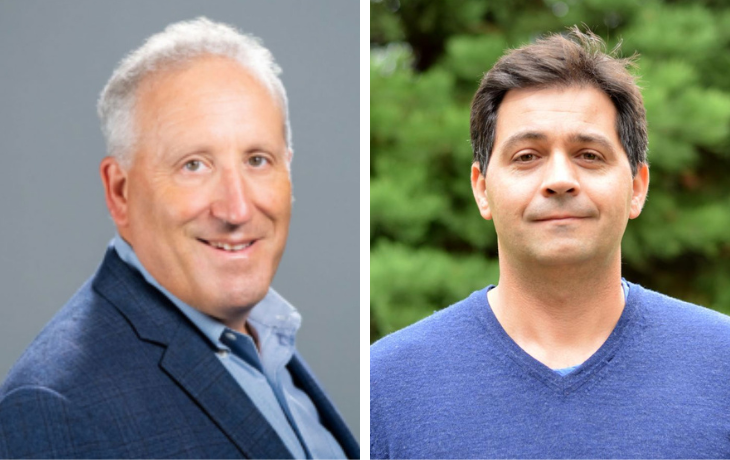College of Natural Resources
UC Berkeley to offer new Master of Climate Solutions
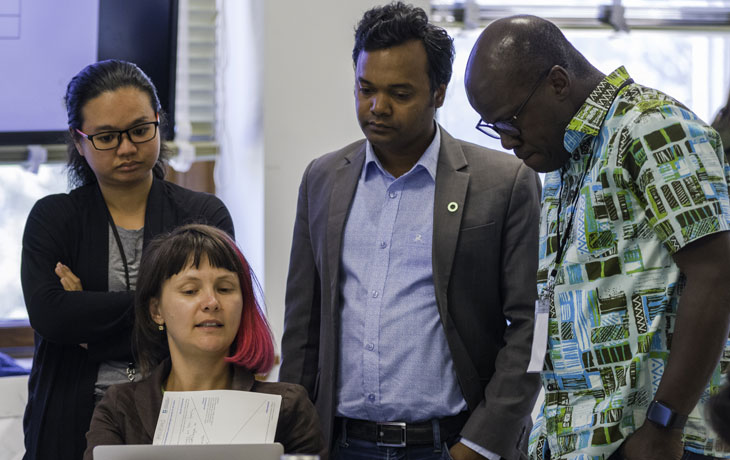 December 26, 2024
December 26, 2024 Offered as a one-year program or a concurrent degree with the Haas MBA, Rausser College’s Master of Climate Solutions will empower leaders to enact solutions to the climate crisis.
Three seniors named winners of the 2024 Babcock Prize
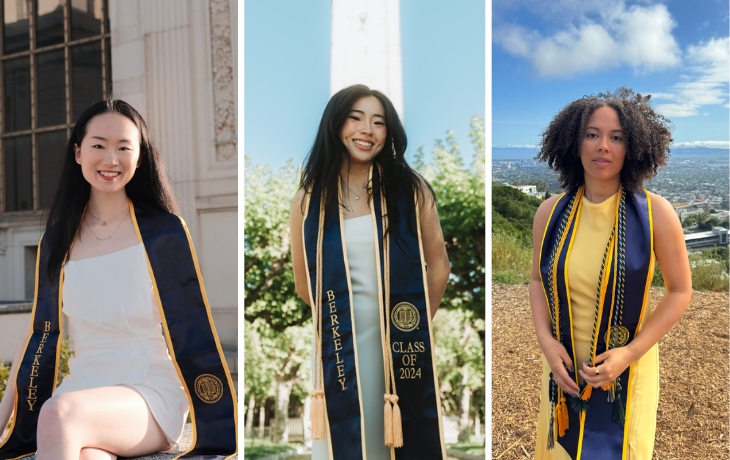 May 08, 2024
May 08, 2024 Endowed as a tribute to longtime soil chemistry professor Kenneth Babcock, the prize recognizes high-achieving ESPM undergraduates.
Continuing Berkeley’s legacy in forest products

Cooperative Extension professors Daniel Sanchez and Paul Mayencourt build on the University of California Forest Products Lab’s 50-year history through their research on innovative, low-carbon wood products.
By Mathew BurciagaWhen the University of California Forest Products Laboratory opened its doors at the Richmond Field Station a few miles north of the UC Berkeley campus in 1955, leaders within the California state government hoped the new facility would provide a centralized hub for research on wood products and processing.
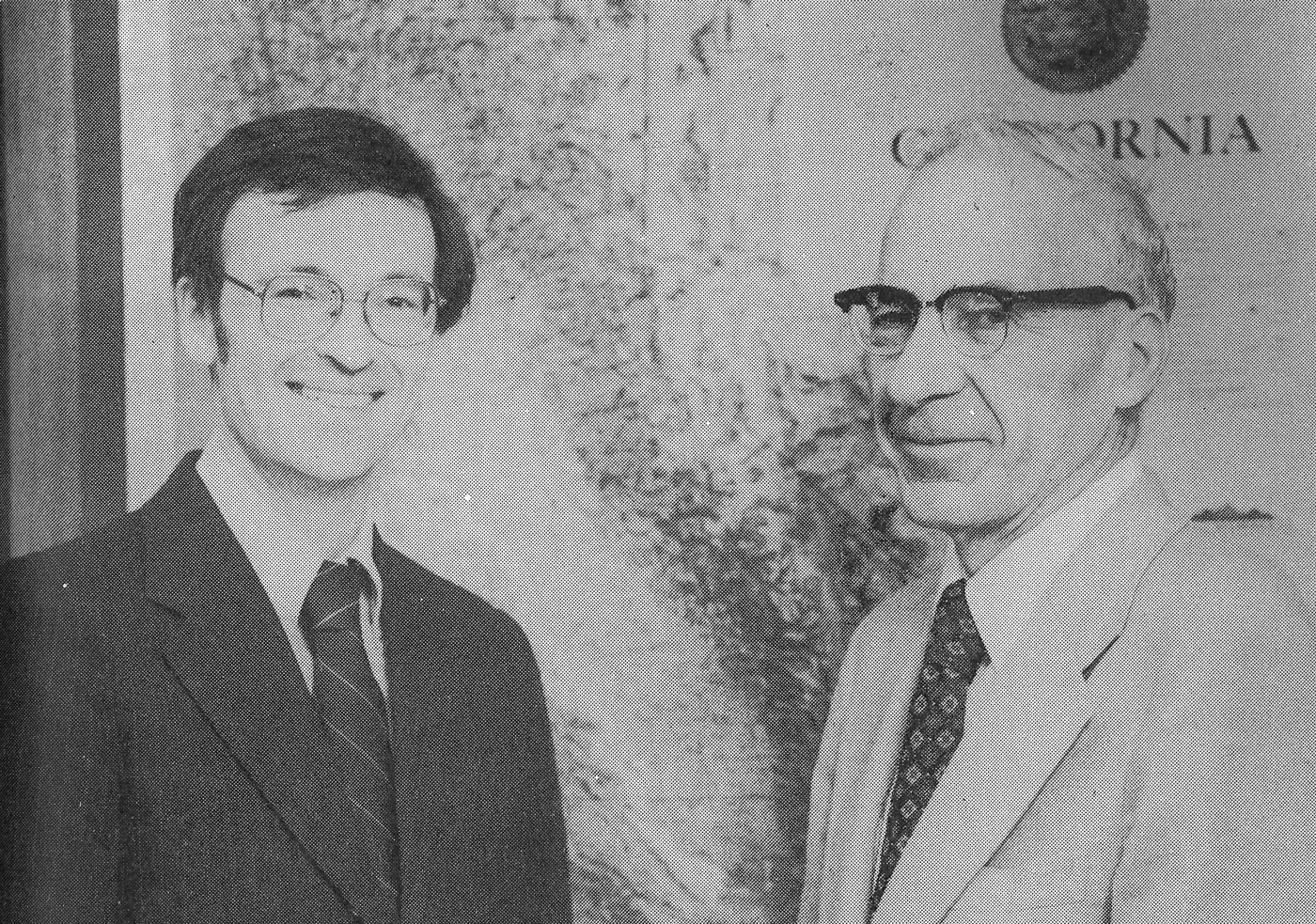 [image caption]
[image caption]
Forest Products Lab Director Fred Dickinson (Right) and Donald Arganbright, his successor, in 1980. Photo from 1980 Forest Products Lab Annual Report.
Before then, research in wood technology and forest products occurred at various UC Berkeley locations. From 1903 to 1909, the College of Engineering operated a timber testing laboratory in partnership with the U.S. Forest Service (then the Bureau of Forestry). The Forest Service operated a research kiln in the Berkeley Hills for a few years beginning in 1911. Most notably, the University introduced its undergraduate forestry degree in 1914—a program that has evolved and expanded over the past 110 years.
In the 1940s, lawmakers in California and across the U.S. began investing in laboratories and facilities dedicated to developing next-generation wood products and technologies to further capitalize on wartime developments. By 1953, the California legislature approved the creation of the Forest Products Lab and allocated $1 million in startup funds.
Fred Dickinson, who previously led the Department of Wood Technology at the University of Michigan, was recruited to the UC Berkeley faculty in 1955 as a professor of forestry and inaugural director of the Forest Products Lab. He led the Lab for its first 25 years, building up a research and teaching program that would continue for roughly 50 years. Today, the Lab’s legacy lives on through the efforts of Rausser College researchers who are exploring new and innovative applications of wood products to help California meet its climate and carbon sequestration goals.
Early yearsIn a history recounting the Forest Products Lab’s first 25 years, Dickinson wrote that he sought to create an “institute concerned with mission-oriented research,…basic and applied investigations,…and educational activities at the graduate and undergraduate levels.” University of California President Robert Gordon Sproul appointed a technical advisory board of industry representatives to help inform the Lab’s activities and operations.
 [image caption]
[image caption]
Left: Two people prepare a compression test of full-diameter wood piling. Center: A researcher operates a differential scanning calorimeter. Right: A view of the wood pulping laboratory. Photos from the Forest Products Laboratory: The First 25 Years (Left and Right) and 1975 Annual Report (Center).
At its onset, the Lab provided space for students and faculty to explore novel and commercial research relating to the biology, chemistry, and physics of wood. Dickinson purchased a circular sawmill, three dry kilns, low- and high-pressure boilers, and conventional wood shop equipment like a joiner and table saw with the funding approved by the state. Arthur Anderson, a biochemist and lecturer in the School of Forestry and Conservation, was appointed head of the Division of Wood Products Chemistry as Dickinson continued to recruit faculty and support staff. The Lab established a dedicated library and introduced a master’s degree in Wood Technology in 1956, hired William A. Dost as its first Cooperative Extension specialist in 1962, and welcomed its first PhD students in 1964.
According to Dickson, the Lab had recruited enough faculty and assistants by the late 1970s to allow their teaching and research programs to “...evolve considerably, but with a continued recognition of the importance of the Laboratory to the State’s forest products industries.” Robert A. Cockrell and Arno P. Schniewind led inquiries into the technical and mechanical properties of California’s native hardwoods. Eugene Zavarin and David L. Brink worked alongside Anderson on chemical studies of several tree species and processing techniques. W. Wayne Wilcox focused on increasing the efficiency of California’s timber harvest by investigating the influence of biological factors like decay and bacteria. Dickinson retired in 1980 after 25 years as the Lab’s director. Forestry professor Donald G. Arganbright succeeded him, serving as director until 1986.
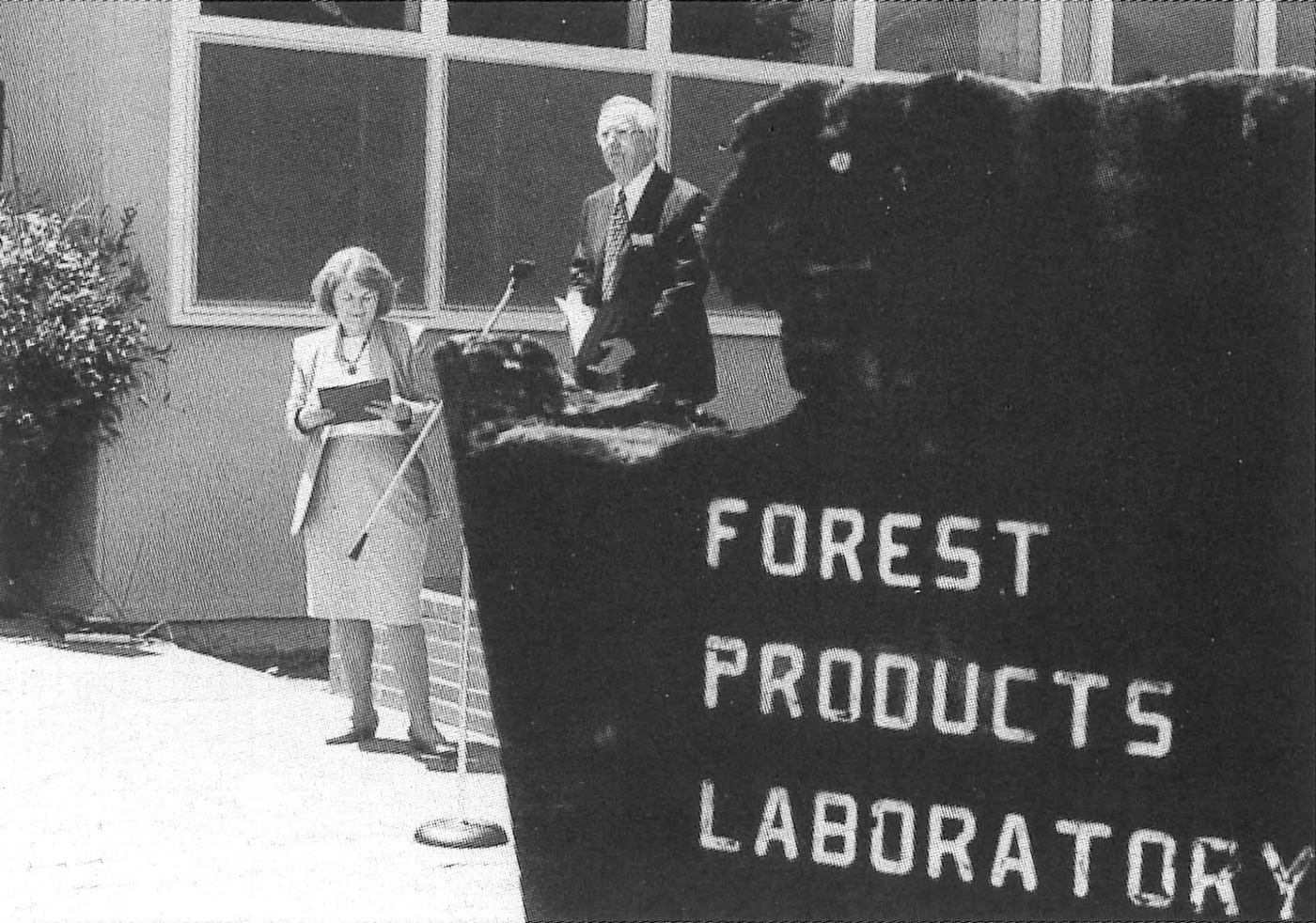 [image caption]
[image caption]
Frank Beall, right, at a May 2000 open house for the California Department of Forestry and Fire Protection. Photo from Forest Products Lab 2000 Annual Report.
The university recruited Wood Science professor Frank Beall to lead the Lab two years after Arganbright's departure. As director, Beall initially pursued research programs on building materials and woody biomass, the byproducts created during the management of forest, woodland, or rangeland environments. Three research centers focused on structural pests, nondestructive evaluation (NDE) of wood and wood-based materials, and service to industry were created to support outreach efforts.
Changes and transitionsIn July 1995, program administration was transferred from the College of Natural Resources to the statewide Division of Agriculture and Natural Resources (UCANR). Doing so expanded the Lab’s footprint from a UC Berkeley research center to a statewide program linking research across the University of California system. Beall hired John Shelly, MS ’77 PhD ’88 Wood Science and Technology, as a Cooperative Extension advisor and worked with UCANR leaders to shift its focus to four new areas: wood durability, fire performance, nondestructive evaluation (NDE) of wood and wood-based materials, and utilization of woody biomass. “This is a departure from our former and broader two-program emphasis. Each of the four programs interlink strongly with several others,” Beall wrote in a 1999 annual report.
By 2001, the Lab was able to hire two additional Cooperative Extension advisors—home fire-protection expert Stephen Quarles and retired Forest Service deputy director Kenneth S. Blonski—but retirements and separations jeopardized its long-term future. Wilcox left that summer, leaving Beall as the sole faculty member in Wood Science and Technology. The Lab closed in 2004, and UC Berkeley discontinued the Wood Science and Technology graduate program shortly after. Over 100 graduate students completed their master’s and doctorate degrees during the program’s run.
 [image caption]
[image caption]
Left: John Shelly measures the drying characteristics of tanoak lumber. Right: Extension staff lead a hardwood lumber drying workshop in Mendocino County. Photos from the 2001 and 1998 Forest Products Lab annual reports.
Quarles and Shelly continued their research and outreach through UCANR’s Woody Biomass Utilization Group, which was created in 2005 as an outgrowth of the Forest Products Lab. With support from state and federal partners, the research group began to study new technologies and processes capable of turning diseased, dying, and small-diameter trees—things that would otherwise burn during fires or decay during forest management treatments—into fuel, structural and non-structural wood products, and lumber.
A new focus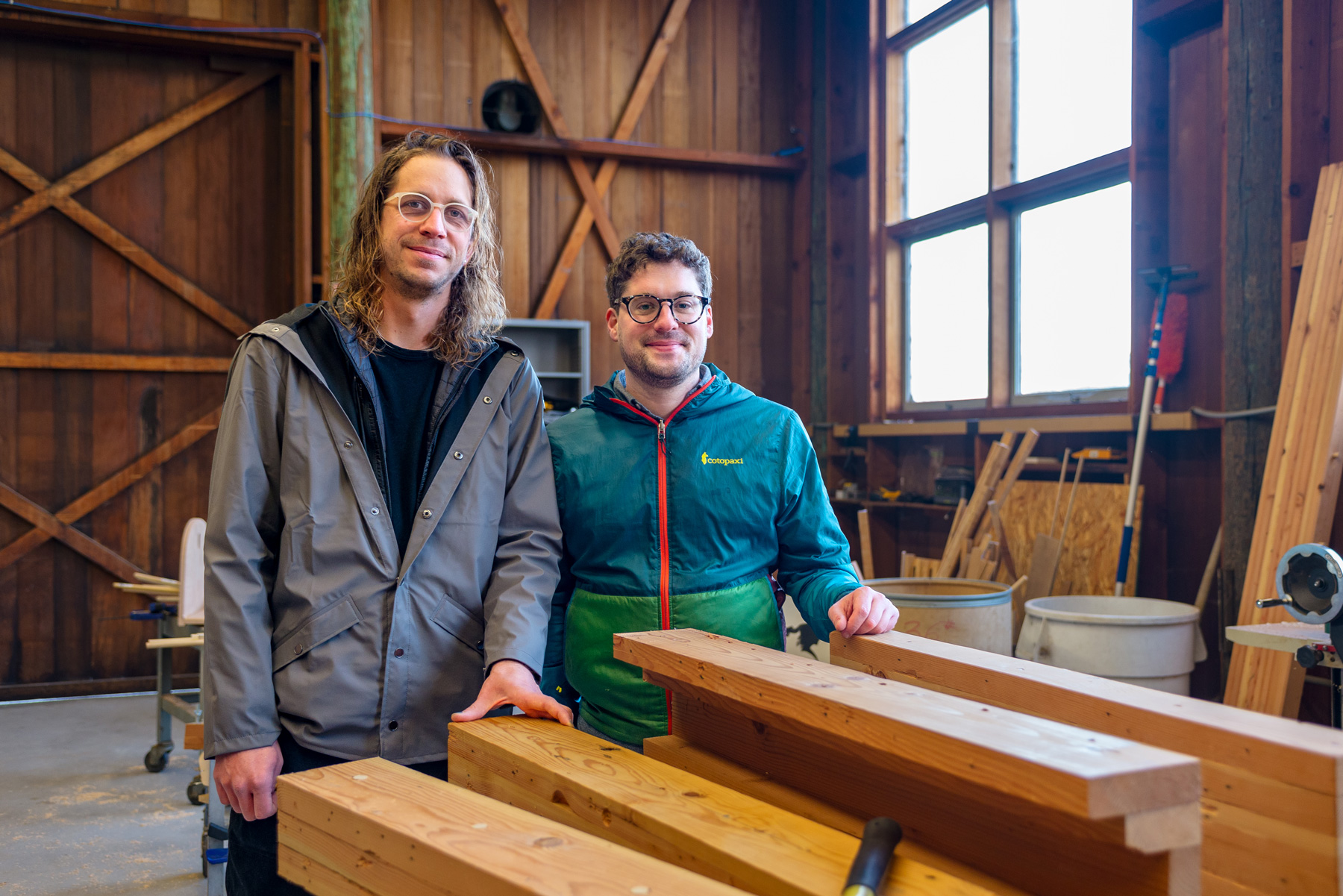 [image caption]
[image caption]
Assistant Professors of Cooperative Extension Paul Mayencourt and Daniel Sanchez in the woodshop at the Richmond Field Station, formerly the site of the Forest Products Lab. Photo by Mathew Burciaga
Daniel Sanchez (PhD ’15 Energy and Resources Group), who has studied the intersection of bioenergy, climate policy, and carbon capture and sequestration for the last decade, notes that “there has been a renewed interest in exploring innovative wood products and their interface with forest management and fire risk reduction in the state of California.” He joined the College in 2018 as an assistant professor of Cooperative Extension focused on woody biomass utilization and now directs the Carbon Removal Lab, which continues some of the research conducted at the former Forest Products Lab.
Much of Sanchez’s research is dedicated to scaling and commercializing various technologies and products that remove carbon dioxide from the atmosphere. He also conducts outreach efforts geared toward policymakers and technologists to help encourage the adoption of these new approaches. In the past few years, Sanchez has begun exploring how low-value and waste biomass from forests and lumber production could be utilized elsewhere. To further that work, Sanchez helped recruit Paul Mayencourt, an expert on engineered and structural wood products, as an assistant professor of Cooperative Extension in the Departments of Environmental Science, Policy, and Management and Architecture.
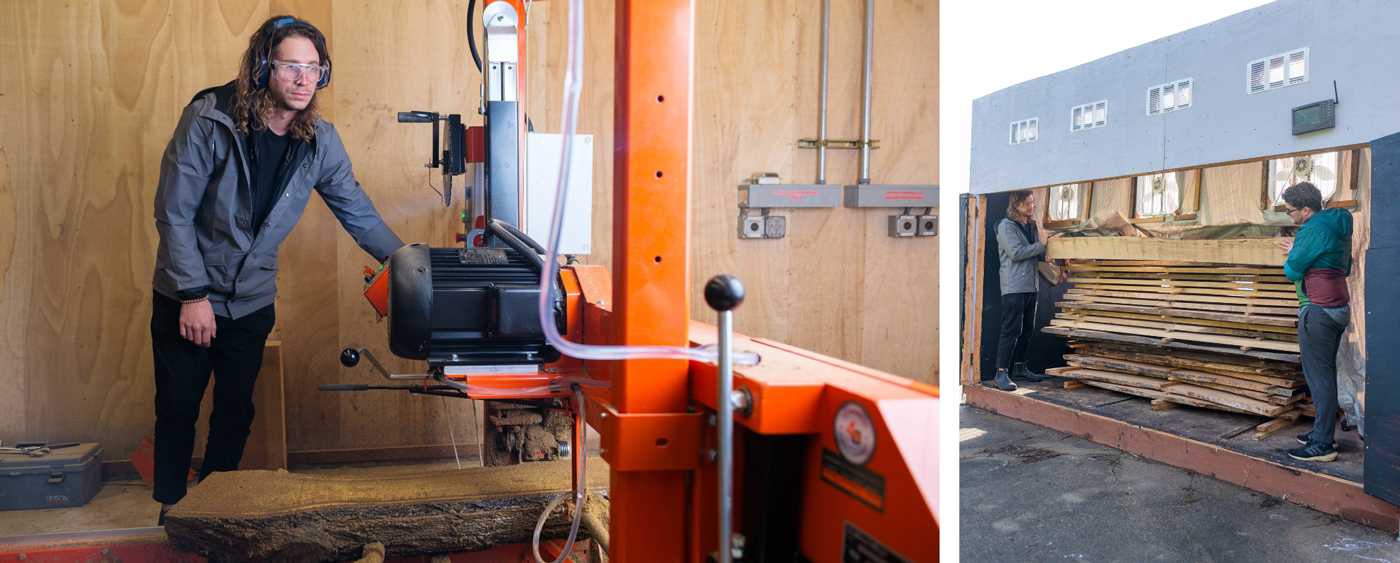 [image caption]
[image caption]
Left: Mayencourt prepares to run a log through a portable sawmill. Right: Mayencourt and Sanchez examine pieces of black oak and madrone lumber that have been drying in their solar kiln. Photos by Mathew Burciaga
A former postdoctoral researcher in the Carbon Removal Lab, Mayencourt’s research merges the fields of structural design, forestry, and materials to explore low-carbon approaches for building structures by leveraging recent advances in manufacturing technologies and computational optimization. Together, Sanchez and Mayencourt have worked to clear out and revitalize former Forest Product Lab facilities, turning them into “a space where we can take any trees and turn them into wood products used for architecture or build scale demonstrations,” said Mayencourt
The pair have since acquired a portable sawmill, designed and built a kiln that can dry wood using solar power, and repurposed existing equipment to run a wood fabrication shop. They are currently testing engineered mass timber products, created when layers of wood are fixed together using adhesive or non-adhesive joiners (like dowels), for use in residential and commercial construction projects. “There is a lot of interest in mass timber because it’s a good material for sustainable and low-carbon buildings,” Mayencourt said, noting that these components can be easily fabricated from small-diameter softwood trees and native California hardwoods like tanoak—which rarely make it to commercial sawmills and are often left to rot or burn in forests. “We’ve built some proofs of concept for companies and hope to see these ideas make their way into the industry.”
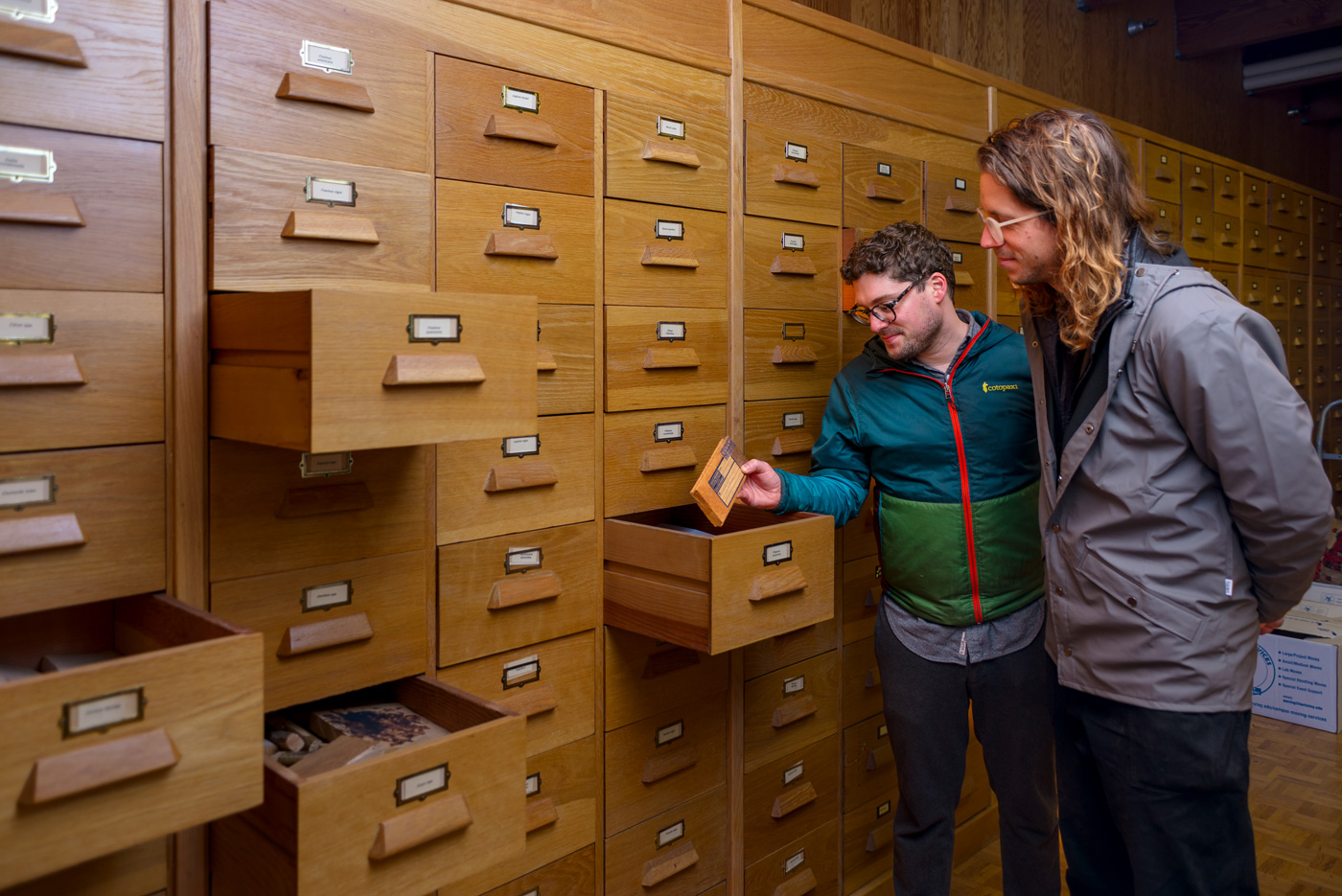 [image caption]
[image caption]
Sanchez and Mayencourt in the Forest Products Lab’s former wood library, which contains thousands of wood samples dating as far back as 1900. Researchers from UC Berkeley and beyond occasionally reach out requesting access to the historic samples. Photo by Mathew Burciaga
Sanchez and Mayencourt also leverage new technical and computational tools to reevaluate existing manufacturing processes to determine whether they can be improved or modified. They are currently working with the California Department of Forestry and Fire Protection (CAL FIRE) on a grant-funded project to explore a new method of producing wood veneers that is cheaper and recovers more material. They plan to hire a full-time staff member to lead fabrication within the wood shop as they grow their research program and hope to host an architect and graduate student researchers as well.
Read More
- Trunk to Table: Forest Stewardship visits the modernized UC Wood Products Lab at the Richmond Field Station (UCANR)
- Cooperative Extension Specialists: Incubating Climate Change Solutions (Breakthroughs magazine)
- Forest to frame: Paul Mayencourt bridges forest management and sustainable construction (College of Environmental Design)
Student Spotlight: Vitto Resnick
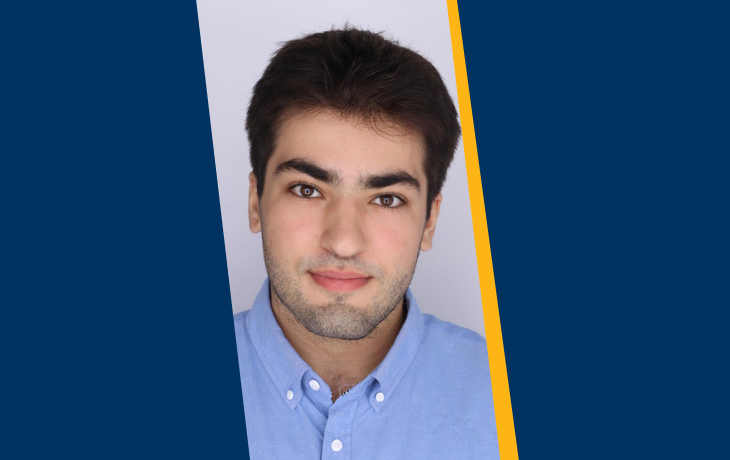 May 06, 2024
May 06, 2024 Resnick will achieve an extremely rare feat: graduating with four bachelor’s degrees in psychology, chemical biology, nutritional science–physiology and metabolism, and molecular and cell biology–neurobiology.
Christopher Schell named chapter lead author on National Nature Assessment
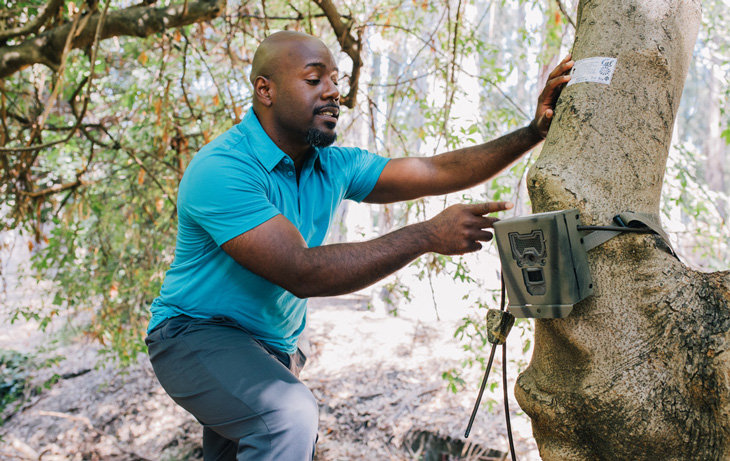 May 02, 2024
May 02, 2024 The ESPM professor and urban ecologist will lead the Nature and Equity chapter of the first-ever national assessment of lands, waters, wildlife, and ecosystems in the U.S.
Enter our 50th Anniversary Photo Contest
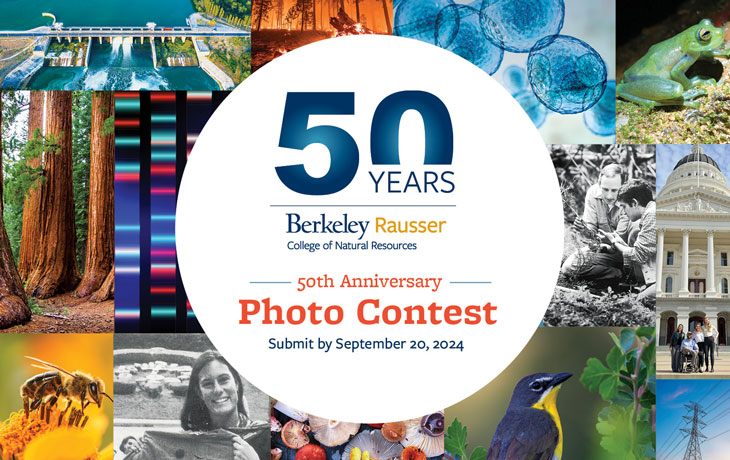 May 02, 2024
May 02, 2024 Help celebrate the 50th anniversary of Rausser College of Natural Resources by entering our 2024 photo contest! Submit your original photos for a chance to win prizes and to have your work featured in Rausser College publications and social media.
Amanda Okamoto receives the Chancellor’s Outstanding Staff Award
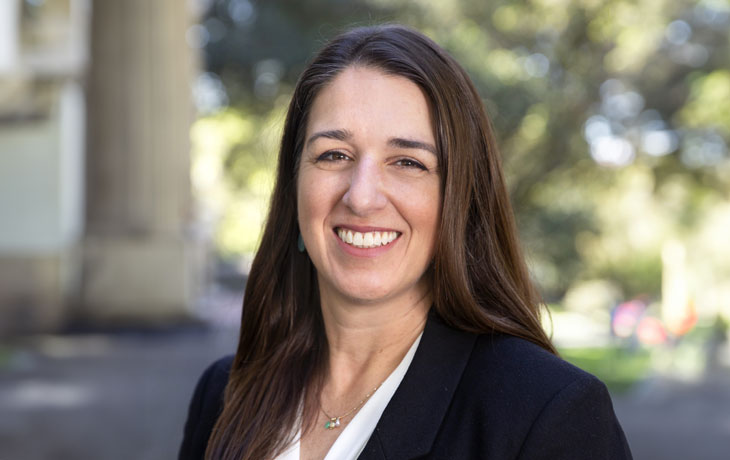 May 01, 2024
May 01, 2024 Okamoto, department manager for the Energy and Resources Group, was recognized for her significant contributions to DEIBJ within the UC Berkeley community.
A win-win for people and the environment
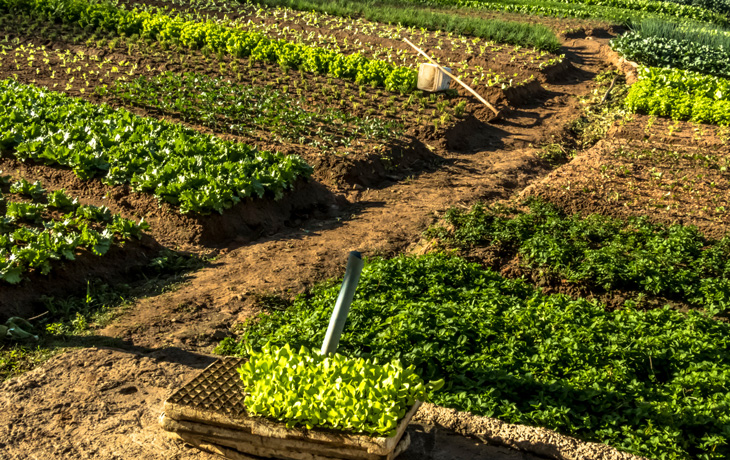 April 24, 2024
April 24, 2024 A Science study co-authored by Kathryn De Master and Adrian Lu, PhD '20, found evidence that diversified farming practices maintain soil health and on-farm biodiversity while also increasing crop yields, food security, and human wellbeing.
ESPM’s Damian Elias receives UC Berkeley’s top Equity award
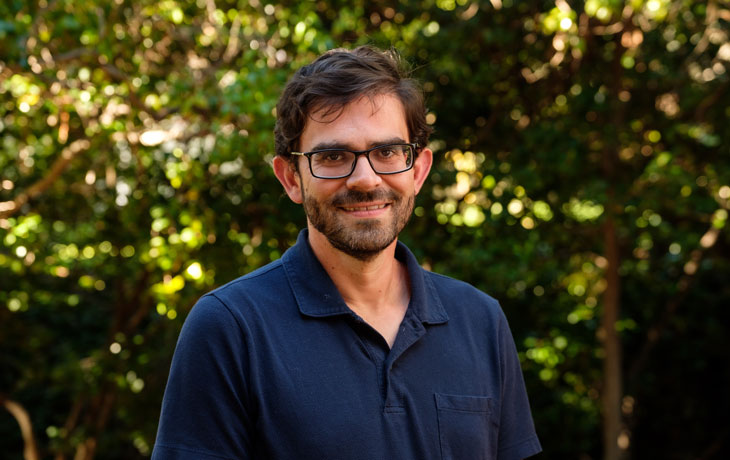 April 15, 2024
April 15, 2024 The Chancellor's Award for Advancing Institutional Excellence and Equity recognizes UC Berkeley faculty who have demonstrated exceptional dedication to advancing DEIBJ efforts.
Spring 2024 ESPM faculty book panel
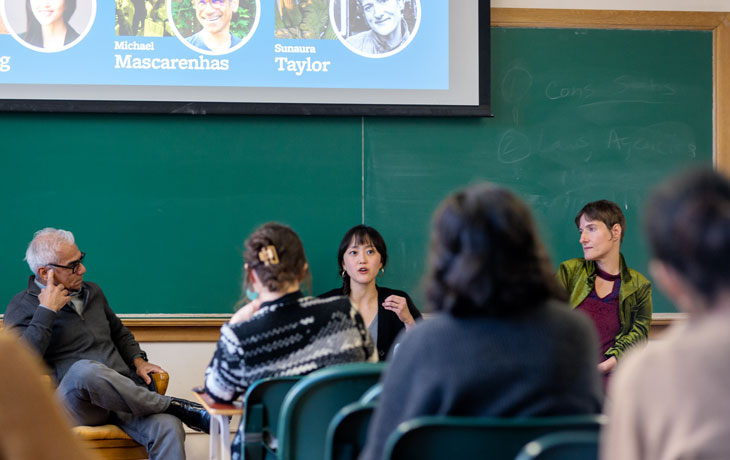 April 11, 2024
April 11, 2024 ESPM Professors Sunaura Taylor, Youjin Chung, and Michael Mascarenhas discussed their latest books with Rachel Morello-Frosch earlier this semester.
Advancing scientific understanding of calcium signaling
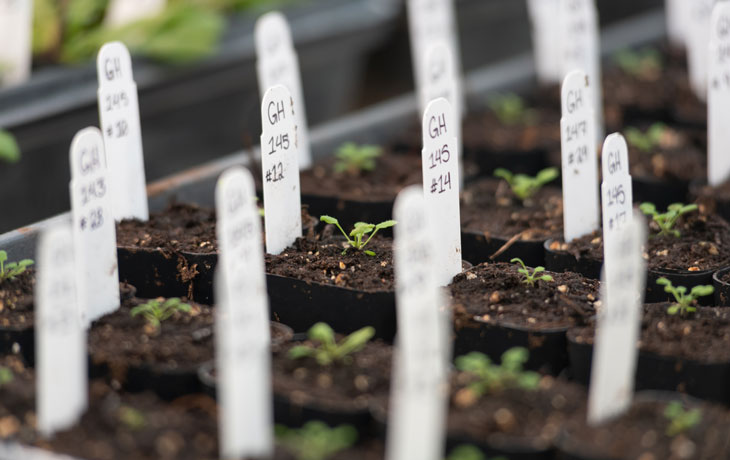 April 11, 2024
April 11, 2024 Recent studies led by Plant and Microbial Biology professor Sheng Luan shed light on the role calcium plays in plant immunity and defense.
Only China is on track to meet global renewable energy commitments
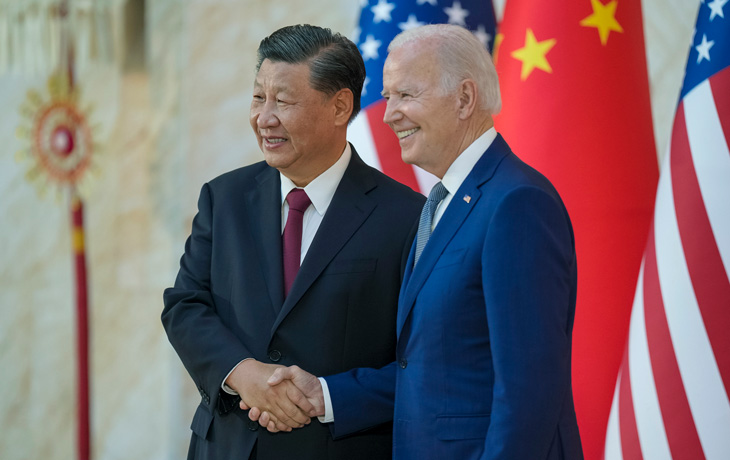 April 08, 2024
April 08, 2024 New analysis from University of California, Berkeley researchers finds that China is the only nation on track to triple its renewable capacity by 2030, a key goal for limiting global warming to 1.5 degrees Celsius.
2024 State of the College Address
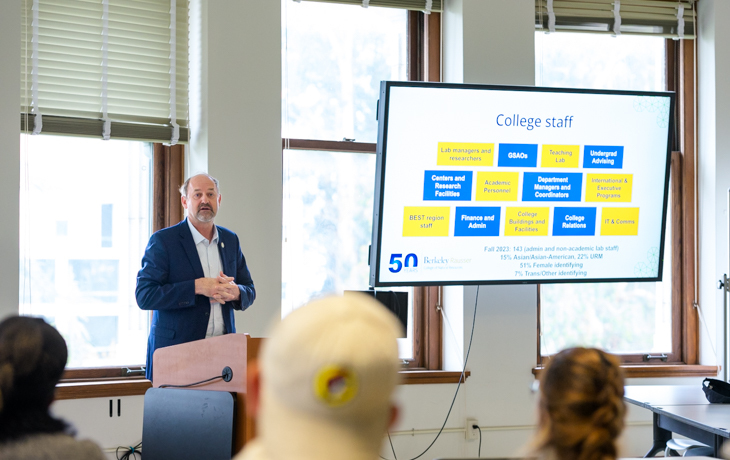 April 05, 2024
April 05, 2024 In his annual State of the College address, Dean David Ackerly covered topics such as recruitment, staffing, and students; strategic plan implementation; the College’s 50th anniversary celebrations, and budget and philanthropy.
Two Rausser College undergrads honored with 2024 Sustainability Awards
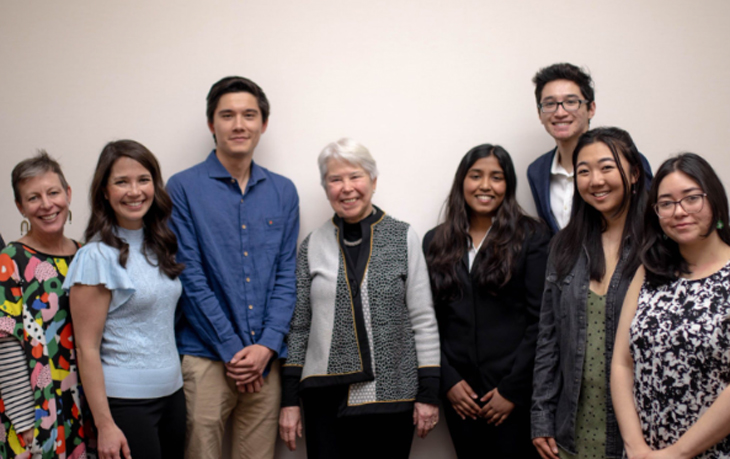 April 04, 2024
April 04, 2024 Tatum Hurley and Brisa Alvarez were recognized for their efforts to make UC Berkeley a more sustainable place to work, live, and learn.
In Memoriam: Carroll B. Williams, Jr.
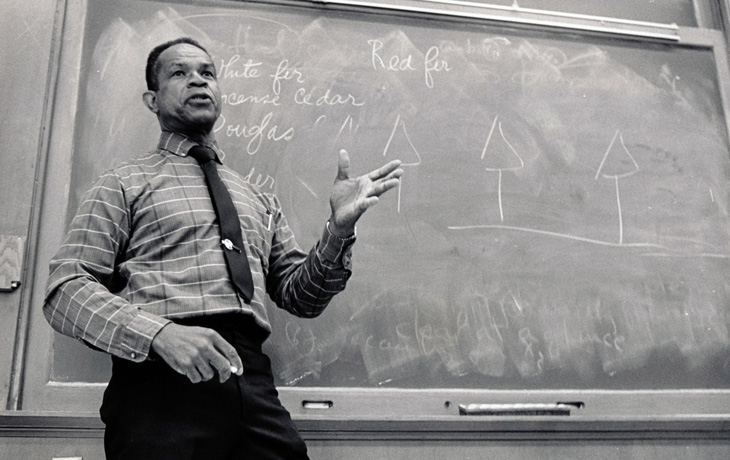 April 01, 2024
April 01, 2024 The pioneering environmental scientist and former senior lecturer passed away on March 1. He was 94
Strengthening nature-based climate solutions at the federal level
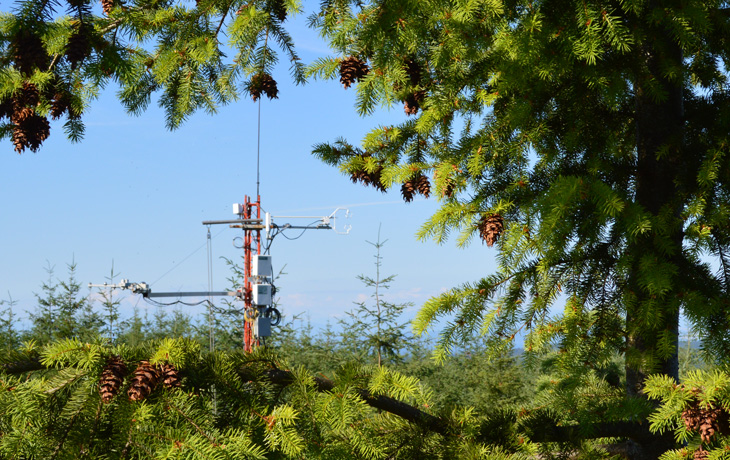 March 29, 2024
March 29, 2024 In a PNAS opinion, professors Dennis Baldocchi, Trevor Keenan, and Margaret Torn join experts in recommending ways to strengthen the scientific foundation for Nature-based Climate Solutions.
Fostering Indigenous Co-Stewardship of Public Lands
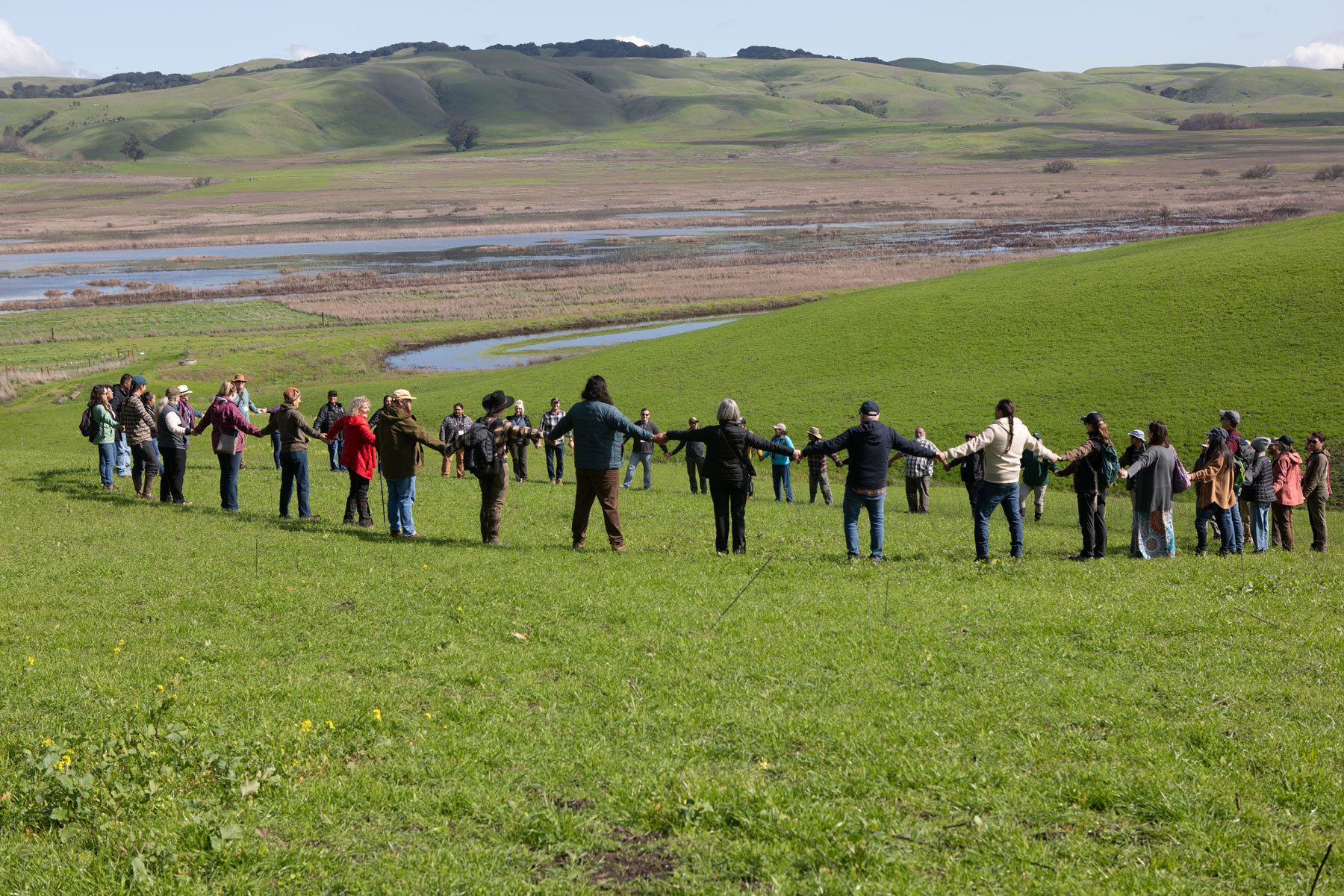 [image caption]
[image caption]
Attendees of the field trip to Tolay Regional Park joined hands, reflecting on the area to which fire had returned after over 100 years. Photo by Lobsang Wangdu.
On a sunny Wednesday morning in Rohnert Park, California, Tribal leaders, Indigenous culture bearers, academics, and representatives of land management agencies from the places now known as the United States, Canada, and Mexico gathered for a two-day event focused on creating substantive, long-term agreements for Indigenous co-stewardship of public lands. Some attendees were meeting for the first time at The Event at Graton Resort and Casino, some were enjoying seeing collaborators in person after many meetings held via Zoom, and some renewed long standing relationships after too much time apart.
Titled “Indigenous Co-Stewardship of Public Lands: Lessons for the Future,” the event was presented in partnership by the California Biodiversity Network (CBN) and the Federated Indians of Graton Rancheria (FIGR), with grants from the Gordon & Betty Moore Foundation and Resources Legacy Fund. FIGR’s significant contributions included providing the conference facility, planning, technology, food, and field transportation. Event partners included the UC Berkeley Institute for Parks, People, and Biodiversity, California Natural Resource Agency (CNRA), The Stewardship Network, Hispanic Access Foundation, Native California Research Institute, East Bay Regional Park District, Indigenous Stewardship Network, and 30x30 California.
The agenda included presentations on substantive, long-term co-stewardship agreements, hearing from proven communities of practice about co-management models, and offering attendees the opportunity to visit and learn about long-term co-management agreements initiated by FIGR at two Northern California places designated as public parks.
Advancing conservation, access, and resilience through Tribal partnershipsDuring the event’s opening remarks, Dr. Ana Alvarez, Deputy General Manager of the East Bay Regional Park District and a member of the California Biodiversity Network steering committee, referred to the Pathways to 30x30 report, issued by the CNRA on Earth Day 2022 that outlines priorities to advance the conservation of 30% of California lands and coastal waters by 2030, with three key objectives: protect and restore biodiversity, expand access to nature, and mitigate and build resilience to a changing environment through nature-based solutions. She said the report stressed that these objectives should be pursued while embracing a commitment to strengthening partnerships with California Native American Tribes. The conference aimed to address research priorities from the report and was intended to “spark a paradigm shift, laying the foundation for meaningful and mutually beneficial Tribal management and co-management of public lands by creating the opportunity to learn from successful models,” said Alvarez.
Dr. Beverly R. Ortiz, Chair of the Native California Research Institute, also provided perspective as the event began. “Before there were public lands, before there was this thing called co-stewardship and co-management of public lands, there was stewardship of land. There was Traditional Ecological Knowledge. There were culture bearers,” she said. “It was a system of relationships—with creation, with previous generations, with plants, other animals, the minerals, the rocks.” Ortiz went on to acknowledge the “tremendous upheaval and change that Native people have endured, survived, and thrived through because of the generosity, the caring with kindness, the goodness of the elders.” It is these culture bearers and these elders, she said, whose resilience and forward-thinking formed the basis of all that’s being done related to co-stewardship today.
Miracles, Healers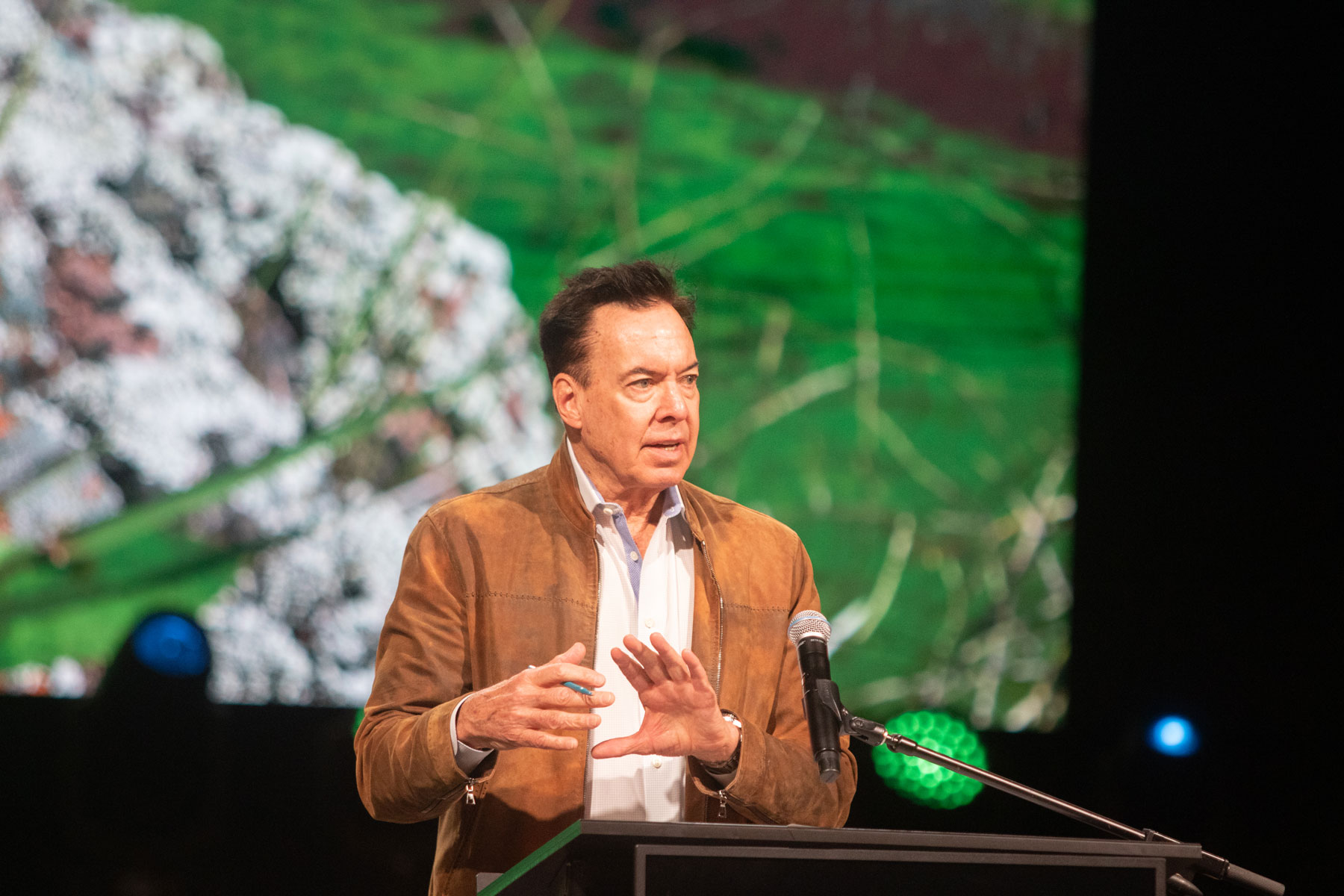 [image caption]
[image caption]
The Honorable Greg Sarris, Chair of the Federated Indians of Graton Rancheria. Photo by Lobsang Wangdu.
Next, The Honorable Greg Sarris, Chairman of the Federated Indians of Graton Rancheria, spoke of Spanish and then Mexican colonization of Coast Miwok and Southern Pomo Tribes of Marin and Sonoma Counties. “What happened to the people happened to the land,” he said. “As we were put in missions, new species of grasses colonized the Indigenous grasses.” He further discussed the enslavement of Indigenous people through indentured servitude, vagrancy laws, and convict leasing, and how the state of California continued the environmental degradation started during colonization. “The water table in the area was lowered by 50 feet, and the last grizzly bear was killed,” he said. “By the 20th century, only 5 to10% of the Indigenous population remained, and the same percent of the original redwood grove was left,” he said. “The land was radically changed.”
Sarris referenced a term in Kashaya, the language of the Western Pomo, which referred to white people as “miracles.” Elders told him they called white people “miracles” because they’d always believed that if you harm nature or one another, something would come for you—you’d “get fixed.” But the white people arrived—killing animals and people, chopping down the trees, damming the water—and instead of getting punished, more of them kept coming. “Today, as we know, nobody turns out to be a miracle, because in fact, it's all coming back on all of us,” Sarris said. “There is no water, there is no air that isn’t poisoned. We know that we and future generations are being punished. But today we gather as Indian and non-Indian alike and want to change that. We know that we are all in this together. Luckily and miraculously, Indigenous knowledge survives. We can share.”
Sarris then described co-stewardship of public lands as an avenue to begin to heal the extreme damage done to both the land and the people. He outlined the two co-stewardship agreements that FIGR has made. One, at Tolay Lake Regional Park in Sonoma County, is believed to be the first of its kind in California between a local government and a federally recognized tribe. The second is a precedent-setting agreement with Point Reyes National Seashore and the National Park Service. Sarris noted that the most important thing when negotiating co-stewardship agreements is that Tribes have at least 50/50 control, and even more when it comes to sacred spaces. “Co-management can’t be where we’re just advisors invited to the table but somebody else has power,” he said. “You make sure that regarding sacred sites, restoration, land use…that you have equal power to whatever agency you’re working with.”
He closed by acknowledging that the goal cannot be to restore everything to how it used to be. “There has been so much destruction that we need to work together to go piece by piece to restore and heal the land,” he said. “Just as none of us are miracles, all of us can become healers.”
California, U.S., and International AgreementsThe event then focused on the topic of co-stewardship in present-day California, including presentations detailing:
- co-management at Point Reyes National Seashore;
- how the Karuk Tribe is moving from co-stewardship to co-management;
- the formal co-stewardship agreements between the Mooretown Rancheria of Maidu Indians and the Bureau of Land Management; and
- expanding opportunities for Tribal partnerships with California State Parks.
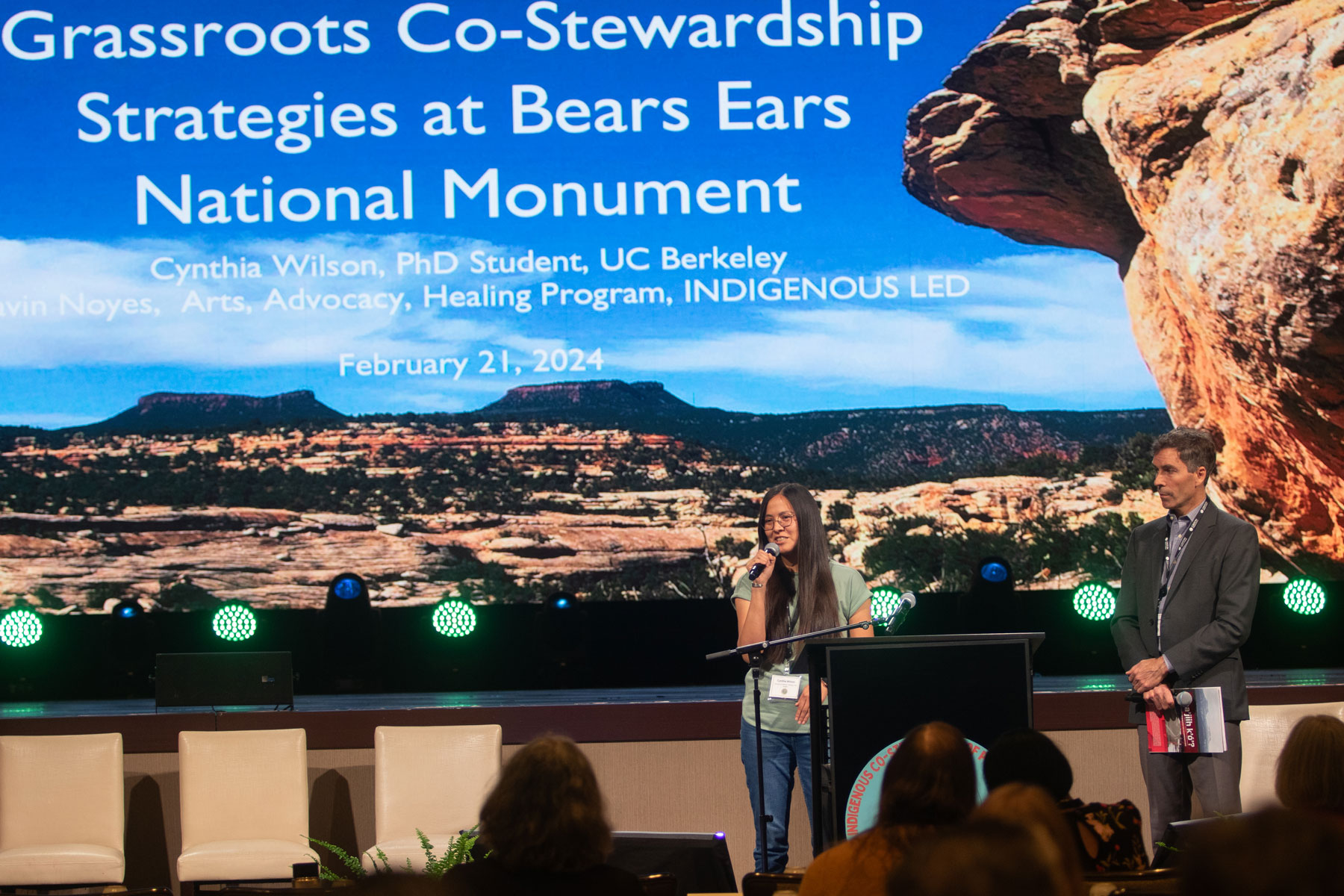 [image caption]
[image caption]
Cynthia Wilson (Diné), a PhD student in UC Berkeley’s Department of Environmental Science, Policy, and Management, discussing co-stewardship efforts at Bears Ears National Monument in southeastern Utah. Photo by Lobsang Wangdu.
Many lessons learned, examples, and useful resources were shared, including the Karuk Tribe’s climate adaptation plan and resources related to how to approach possible agreements at the state park level.
Next, the presentations broadened scope to agreements in other states in the U.S., with sessions moderated by Patrick Gonzalez, Director of the UC Berkeley Institute for Parks, People, and Biodiversity. These included discussions on:
- grassroots strategies at Bears Ears National Monument, Utah;
- co-stewardship of Grand Portage National Monument on Lake Superior between the Grand Portage Band of Lake Superior Chippewa and the National Park Service; and
- formal funding agreements for co-stewardship of the Yukon Flats National Wildlife Refuge in Alaska between the Council of Athabascan Tribal Governments and the U.S. Fish and Wildlife Service.
Cynthia Wilson (Diné), a PhD student in UC Berkeley’s Department of Environmental Science, Policy, and Management began the conversation on co-stewardship efforts at Bears Ears National Monument in southeastern Utah. Wilson is a founding member of the Women of Bears Ears initiative, which seeks to restore Indigenous women’s matrilineal roles and rematriate the earth. She has been active in the efforts to establish Bears Ears as a National Monument. Wilson illustrated how changing presidential administrations have affected Bears Ears, with President Obama designating the 1.36 million acre monument in 2016 followed by President Trump reducing the monument’s size by 85%, and then President Biden reinstating the monument to its original acreage. Due to the controversy, signs were not posted at the monument until about a year ago, she said.
“The presidential proclamation highlighted that Traditional Ecological Knowledge is itself a resource to be protected, and to use for understanding and managing this landscape sustainably for generations to come,” Wilson said, adding that “the land itself is essential to each of our cultures and tribal nations.” She continued to describe how Tribes in the area of Bears Ears interact with the land. “Our ceremonies originated from this place; we go there for firewood, medicine, for food, for art,” she said. “Part of this movement is this place being a living landscape. It's really that restoring that symbiotic relationship of the land and of the people.”
She highlighted the restorative relationships, saying “access to the land is more important than highlighting Indigenous knowledge, because we don't share our knowledge—we practice it. We need to be actively present on these lands for healing of the people and healing of the land.”
Wilson described some activities that exemplify restoring a relationship to cultural resources, including a study on firewood research that consulted with elders; her work rematriating Solanum jamesii, a tiny white potato that is an ancestral food documented 11,000 years ago in the southwest region; and a New York Times Op-Ed published by the Women of Bears Ears.
Co-presenter Gavin Noyes, Arts, Advocacy, and Healing Program Coordinator with the nonprofit INDIGENOUS LED, discussed the importance of nonprofit organizations—in addition to federal and state agencies—in supporting co-stewardship movements. He stressed that nonprofits can be especially helpful when Tribes have little capacity and infrastructure to advance their goals of protecting public lands.
 [image caption]
[image caption]
Left: Minneth Medina, Director of Junta Intermunicipal Biocultural del Puuc (Mayan), speaking on biocultural governance in the Mayan region of Puuc. Right: Armando Quintero, Director of the California Department of Parks and Recreation, outlining options for expanding Tribal Partnerships with California State Parks. Photos by Lobsang Wangdu.
After a lunch break during which attendees continued to make connections and share ideas, afternoon presentations turned toward co-stewardship of public lands internationally. These sessions were moderated by Jonathan Jarvis, board chairman of the Institute for Parks, People, and Biodiversity. Speakers discussed:
- Formal management agreements between First Nations and Parks Canada;
- Community-led conservation collaborations between Indigenous and Local Communities in the Yucatan Peninsula; and
- Biocultural governance in the Mayan Region of Puuc
The day’s presentations ended with a Q&A session and an opportunity for open-mic audience reflections, which included discussion of how co-stewardship works with Tribes that are not federally recognized as well as attendees expressing thanks for the resources shared throughout the day.
Jon Jarvis noted that a forthcoming issue of Parks Stewardship Forum, a free online publication of the Institute for Parks, People, and Biodiversity and the George Wright Society, will capture the ideas, lessons, and models mentioned during the conference and make them available in 2025. “The issue will focus on how to scale, and push for every agency to enter into an agreement that truly creates co-stewardship,” he said.
Don Hankins (Plains Miwok), Co-Lead of the Indigenous Stewardship Network, urged attendees to use this event as an activator, and go on to explore opportunities to push new boundaries and forge new arrangements. “We came to the meeting; now what's the action we will take?” he said.
 [image caption]
[image caption]
Left: Artist Martina Morgan, Kashia Pomo Tribe, displayed a miniature Pomo cradle, a seaweed tray made from willow, clapper sticks, and willow tied up for basket making. Right: Robin Meely, Federated Indians of Graton Rancheria, holding an open twine willow bird catcher.
The day’s formal events were followed by a reception hosted by the Federated Indians of Graton Rancheria, during which attendees could take in several cultural presentations, visit cultural display tables, and sample cultural foods. The following day, field trips to Point Reyes National Seashore or Tolay Lake Regional Park allowed members of FIGR to elaborate on their historic co-stewardship efforts on those lands. At Tolay Lake, park staff shared stories of the many years of dialog, building relationships, and identifying common visions and goals for the park. The PhD work of ESPM assistant professor Peter Nelson, which documented archeological evidence of Indigenous communities who lived on the land, was also discussed. In addition, speakers noted that last year fire was restored to the park’s grasslands for the first time since Spanish colonization.
In comments concluding the formal proceedings of the day, Gregg Castro, (t’rowt’raahl Salinan/rumsien-ramaytush Ohlone), Vice-Chair of the Native California Research Institute, noted that a resounding theme throughout the day was on the importance of relationships, and stressed the value of the work being done. “It's not an easy road, but it's the right road,” he said. “It's not business to us…it's our heart and spirit that we put into this. We’ve learned the tools of business in this new world that we have to live in, but it's who we are and what we do. We’re not from the land, we’re of the land, and the land is of us. And that’s the only way we can do it.”
 [image caption]
[image caption]
Left: Freddie Romero (Federated Indians of Graton Rancheria) during the field trip to Tolay Regional Park, showing a map design for a new outdoor event, educational, and performance space co-designed by the Federated Indians of Graton Rancheria and the Sonoma Regional Parks. Right: Clinical Herbalist/ Traditional Practitioner Sage LaPena (Nomtipom Wintu) showing a Pacific Chorus Frog to attendee Isaiah Thalmayer, Senior Project Manager at Point Blue Conservation Science. Photos by Lobsang Wangdu.
Understanding the velocity of climate change
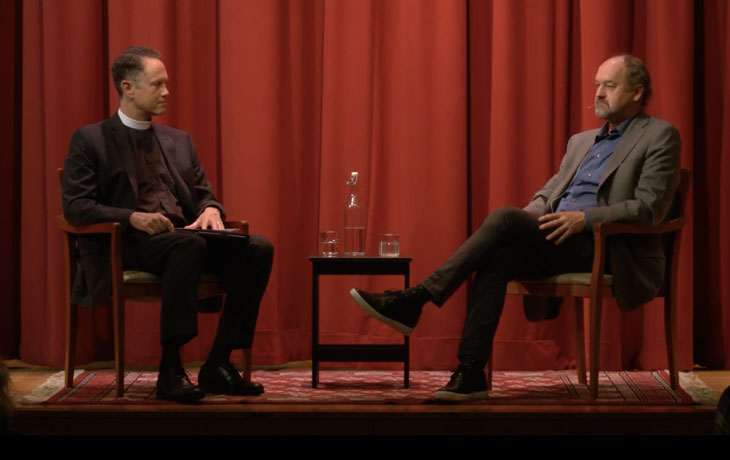 March 27, 2024
March 27, 2024 Dean David Ackerly recently spoke before the congregation of San Francisco’s Grace Cathedral about climate change and our changing world.
Utility-caused wildfires are becoming a national problem
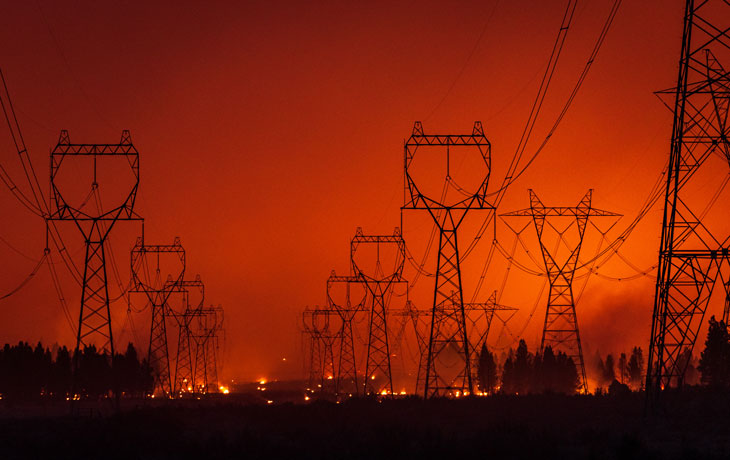 March 25, 2024
March 25, 2024 ERG professor Duncan Callaway spoke to the New York Times about a recent Energy Institute working paper that analyzed PG&E's wildfire mitigation efforts.
